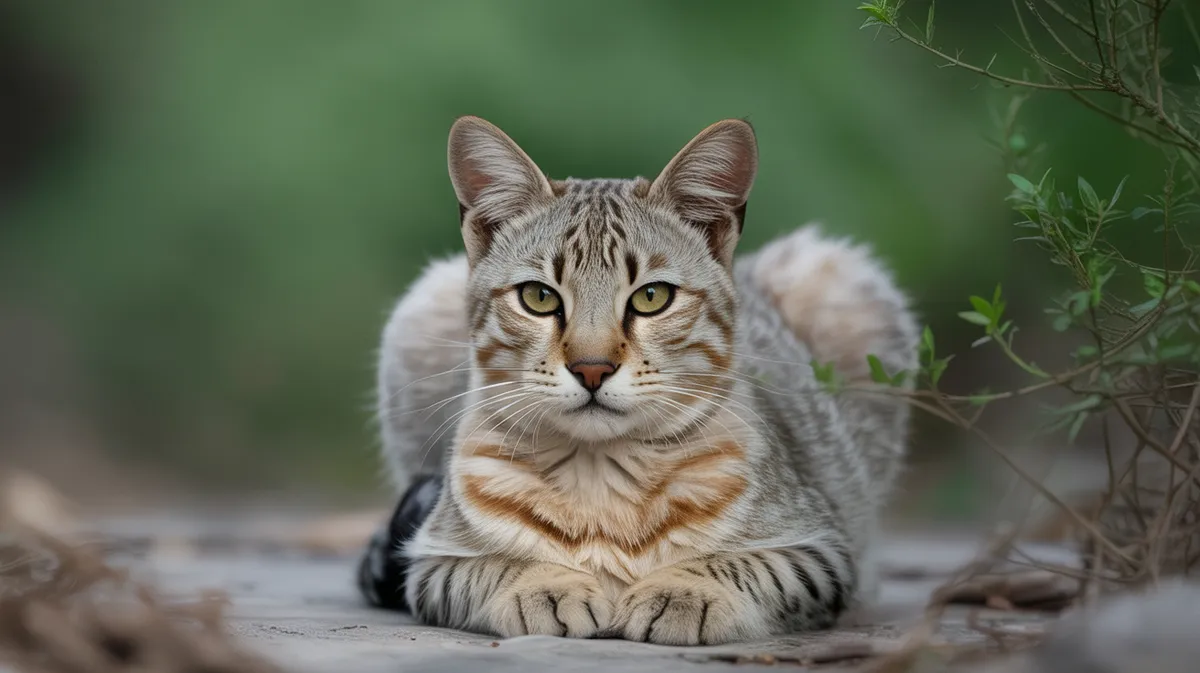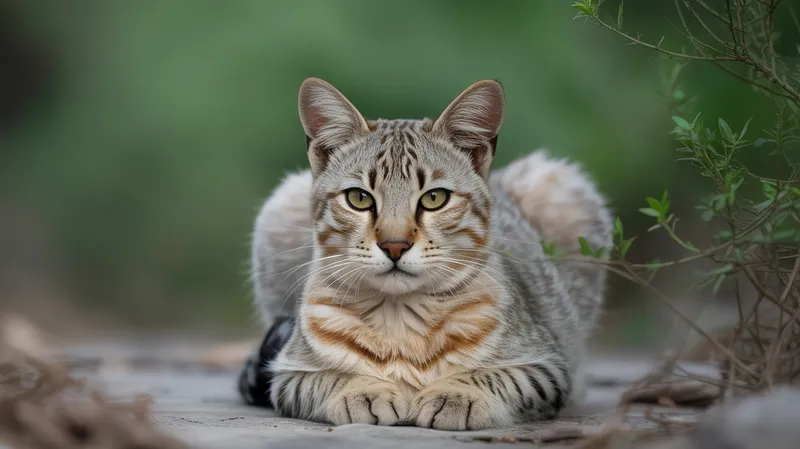
Suphalak Cat
Felis catus

Meet the Suphalak Cat
The Suphalak is a rare and ancient domestic cat breed native to Thailand, known for its striking solid copper or reddish-brown coat. This breed is renowned for its muscular build, golden or yellow eyes, and smooth, close-lying fur. Historically, the Suphalak was considered a symbol of wealth and good fortune in Thai culture and is mentioned in the centuries-old Tamra Maew or 'Cat Book Poems.' Due to its rarity, the Suphalak is seldom seen outside Thailand and is closely related to other native Thai breeds such as the Burmese and the Korat.
Classification
Mammal
Habitat
Domestic, often in homes or urban environments
Diet
Carnivore
Lifespan
12-16 years
Conservation
Rare (Not evaluated by IUCN; breed rarity)
Weight
3-5 kg
📖Fascinating Facts
Ancient Origins
Suphalak cats are featured in the Tamra Maew, a book of cat poems dating back to the Ayutthaya period of Thailand.
Royal Status
These cats were believed to bring wealth and prosperity, and were often kept by members of Thai royalty.
Unique Coat Color
The Suphalak’s coat is a rich, solid copper or reddish-brown, a color not commonly found in other cat breeds.
📋Detailed Description
The Suphalak cat is a medium-sized, muscular domestic breed distinguished by its uniform, rich copper or reddish-brown coat, which is the result of a recessive genetic trait affecting eumelanin pigmentation. Adult Suphalaks typically weigh between 3.5 and 5 kilograms, with males being slightly larger than females. The breed's coat is short, close-lying, and has a satin-like sheen, enhancing its striking appearance. The head is gently rounded with a moderate wedge shape, large, expressive golden to yellow eyes, and medium-sized, slightly rounded ears set well apart. Suphalaks possess a strong, athletic body with a deep chest, straight back, and well-developed limbs, contributing to their agility and prowess. Their paws are oval and compact, and the tail is of medium length, tapering to a rounded tip. Behaviorally, Suphalaks are intelligent, active, and highly social, forming strong bonds with their human companions and often displaying dog-like loyalty. They are known for their vocalizations, curiosity, and playful nature, making them engaging pets. Despite their rarity, Suphalaks are robust and generally free from breed-specific genetic disorders, likely due to their natural landrace origins.
💡 Did you know?
The Suphalak breed was long believed to be extinct, but a few individuals were rediscovered in Thailand in the late 20th century.
🔬Research & Sources
🎭Behavior & Social Structure
Suphalak cats are notably interactive and thrive on social engagement, both with humans and other animals. They exhibit high levels of curiosity and problem-solving ability, often exploring new environments and manipulating objects with their paws. Play behavior is pronounced, with individuals frequently engaging in fetch-like games, climbing, and chasing toys or moving objects. As obligate carnivores, their feeding behavior includes a preference for high-protein diets, and they may display hunting-like stalking and pouncing behaviors even in domestic settings. Suphalaks are moderately vocal, using a range of meows, trills, and chirps to communicate needs or attract attention. They tend to establish strong social hierarchies within multi-cat households, often assuming dominant or central roles. Daily routines include periods of intense activity interspersed with rest, typically aligning with crepuscular patterns (active at dawn and dusk). They are generally adaptable to new environments but require mental stimulation to prevent boredom-related behaviors.
👶Reproduction & Life Cycle
Suphalak cats reach sexual maturity between 6 and 10 months of age, with females typically coming into estrus seasonally, influenced by daylight cycles. Courtship involves vocalizations, scent marking, and mutual grooming. Mating is polygynous, and queens may mate with multiple males during a single estrus period. Gestation lasts approximately 63–65 days, after which litters of 3–5 kittens are born. Kittens are born altricial, blind, and dependent, with eyes opening at 7–10 days. Maternal care is intensive, with the queen nursing and grooming the young until weaning at around 8–10 weeks. Suphalaks exhibit strong maternal instincts, and communal nesting has been observed in multi-female households. Breeding is carefully managed by fanciers to maintain genetic diversity and avoid inbreeding, given the breed's rarity.
🛡️Adaptations & Survival
The Suphalak's short, dense coat is well-adapted to the warm, humid climate of Thailand, providing protection against heat and parasites while requiring minimal grooming. Their muscular build and agile limbs are evolutionary traits favoring climbing, leaping, and rapid pursuit of prey, reflecting their origins as semi-feral landrace cats. The breed's keen senses—particularly acute vision and hearing—aid in nocturnal and crepuscular activity. Social intelligence and adaptability allow Suphalaks to thrive in both rural and urban environments, forming complex social bonds and utilizing human-provided resources. Their vocal communication is an adaptation for maintaining social cohesion and signaling needs in dense, multi-individual settings.
📚Research Sources
🎨Cultural Significance
The Suphalak holds a revered place in Thai culture, historically regarded as a symbol of wealth, prosperity, and good fortune. It is prominently featured in the Tamra Maew ('Cat Book Poems'), a manuscript dating back to the Ayutthaya period (14th–18th centuries), which describes auspicious cat breeds. Ownership of a Suphalak was once believed to bring material success and was reserved for nobility or given as royal gifts. The breed's rarity and beauty have made it a subject of folklore and ceremonial importance, and it continues to be celebrated in Thai art and literature. In modern times, efforts to preserve the Suphalak are intertwined with national pride and the conservation of Thailand's cultural heritage.
🔬Recent Research & Discoveries
Recent genetic analyses have confirmed the close relationship between the Suphalak and other native Thai breeds such as the Burmese, Korat, and Thong Daeng, with mitochondrial DNA studies revealing shared ancestry and unique coat color alleles. Ongoing research by Thai universities and international feline geneticists aims to catalog the breed's genetic diversity and identify markers for health and coat traits. Conservation breeding programs have been initiated in Thailand, with collaboration between local breeders and academic institutions to prevent inbreeding and maintain breed standards. Ethological studies are limited but suggest the Suphalak's behavioral profile is distinct from Western-developed breeds, with higher sociality and adaptability. There is growing interest in documenting the breed's historical and cultural significance as part of broader efforts to preserve indigenous Thai fauna.
🎥Wildlife Videos

อาณาจักรของช้างป่า
Prathom Hanklang

Interesting Facts About Pandas | Panda Facts and Information by Manjari Shukla | Perfect Panda
Interesting Facts About Pandas | Panda Facts and Information by Manjari Shukla #factsaboutpandashabitat ...
Manjari Shukla Voice of World
🌍Habitat Information
The Suphalak Cat typically inhabits Domestic, often in homes or urban environments environments. Suphalak Cats have adapted to their environments with specialized features and behaviors.
Primary Habitat:
Domestic, often in homes or urban environments
More detailed habitat information will be available soon.
🛡️Conservation Status
The Suphalak Cat is currently classified as Rare (Not evaluated by IUCN; breed rarity). Conservation efforts are crucial for preserving this species for future generations.
Common Threats:
- 🏠Habitat loss and fragmentation
- 🌡️Climate change impacts
- 🎯Hunting and poaching
- 🏭Human-wildlife conflict
⚠️Threats & Conservation Challenges
The primary threat to the Suphalak breed is genetic bottlenecking due to its extreme rarity and limited breeding population. Urbanization and habitat loss in Thailand have reduced the prevalence of traditional landrace cats, including the Suphalak. There is also a risk of genetic dilution through crossbreeding with other domestic cats. The lack of formal recognition by major international cat registries limits conservation and breeding efforts. No wild populations exist, and the breed's survival depends on dedicated breeders and cultural preservation. Population trends are difficult to assess due to the absence of comprehensive surveys, but anecdotal evidence suggests numbers remain critically low, with only a few hundred individuals worldwide.
🔬Scientific Classification
Scientific Name
Felis catus
Classification Hierarchy
🔍 About Taxonomic Classification
Taxonomic classification is a hierarchical system used by scientists to classify and organize living organisms based on shared characteristics and evolutionary relationships.
The system moves from broad categories (Kingdom) to increasingly specific ones, with each animal's scientific name typically consisting of its Genus and species.
📝Community Notes
Share your observations and insights about the Suphalak Cat with our community of wildlife enthusiasts.
Join Our Community
Sign in to share your observations and connect with fellow wildlife enthusiasts.
Sign In to ContributeNo community notes yet
Be the first to share your observations about the Suphalak Cat!
Explore Suphalak Cat
Select a tab above to learn more about this amazing animal.
📸Photo Gallery
No photos available for this animal yet.
🌟Discover More Wildlife
Continue your journey of discovery with more fascinating animals from our database
